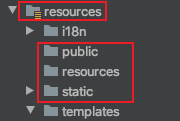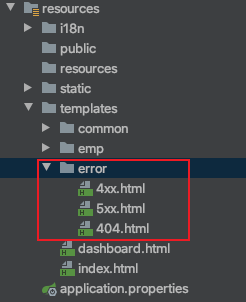目录
- 一、错误处理机制
- 二、ErrorPageCustomizer
- 三、BasicErrorController
- 四、DefaultErrorViewResolver
- 五、如何定制错误响应页面
- 六、DefaultErrorAttributes(错误信息)
- 七、defaultErrorView(默认错误视图)
- 八、如何定制JSON数据

一、错误处理机制
跳转到目录
当访问一个不存在的页面,或者程序抛出异常时
1、默认效果
- 浏览器返回一个默认的错误页面, 注意看浏览器发送请求的
请求头:

- 其他(Postman)客户端返回的是
json数据,注意看请求头

原理:
查看org.springframework.boot.autoconfigure.web.servlet.error.ErrorMvcAutoConfiguration源码,
这里是springboot错误处理的自动配置信息
主要给容器中注册了以下组件:
- ErrorPageCustomizer 系统出现错误以后来到
error请求进行处理;相当于(web.xml注册的错误页面规则) - BasicErrorController : 处理
/error请求 - DefaultErrorViewResolver : 默认的错误视图解析器
- DefaultErrorAttributes : 错误信息
- defaultErrorView : 默认错误视图
二、ErrorPageCustomizer
- 系统出现错误以后来到
error请求进行处理;相当于(web.xml注册的错误页面规则) - 也就是说系统出现
4xx或者5xx的之类状态码的错误; ErrorPageCustomizer就会生效(定制错误的想赢规则), 就会来到/error请求
在ErrorMvcAutoConfiguration中找到ErrorPageCustomizer
@Bean
public ErrorMvcAutoConfiguration.ErrorPageCustomizer errorPageCustomizer(DispatcherServletPath dispatcherServletPath) {
return new ErrorMvcAutoConfiguration.ErrorPageCustomizer(this.serverProperties, dispatcherServletPath);
}
进入ErrorPageCustomizer
private static class ErrorPageCustomizer implements ErrorPageRegistrar, Ordered {
private final ServerProperties properties;
private final DispatcherServletPath dispatcherServletPath;
protected ErrorPageCustomizer(ServerProperties properties, DispatcherServletPath dispatcherServletPath) {
this.properties = properties;
this.dispatcherServletPath = dispatcherServletPath;
}
//注册错误页面
public void registerErrorPages(ErrorPageRegistry errorPageRegistry) {
ErrorPage errorPage = new ErrorPage(this.dispatcherServletPath.getRelativePath(this.properties.getError().getPath()));
errorPageRegistry.addErrorPages(new ErrorPage[]{errorPage});
}
public int getOrder() {
return 0;
}
}
进入getPath()方法

当请求出现错误后就会转发到/error; 然后这个error请求就会被BasicErrorController处理;
三、BasicErrorController
- 处理
/error请求
@Bean
@ConditionalOnMissingBean(
value = {ErrorController.class},
search = SearchStrategy.CURRENT
)
public BasicErrorController basicErrorController(ErrorAttributes errorAttributes, ObjectProvider<ErrorViewResolver> errorViewResolvers) {
return new BasicErrorController(errorAttributes, this.serverProperties.getError(), (List)errorViewResolvers.orderedStream().collect(Collectors.toList()));
}
进入BasicErrorController类
@Controller
/**
* 使用配置文件中server.error.path配置
* 如果server.error.path没有配置使用error.path
* 如果error.path也没有配置就使用/error
*/
@RequestMapping({"${server.error.path:${error.path:/error}}"})
public class BasicErrorController extends AbstractErrorController {
这个类下面的方法

上面两个方法一个用于浏览器请求响应html页面,一个用于其他客户端请求响应json数据
- 处理浏览器请求的方法中,modelAndView存储到哪个页面的页面地址和页面内容数据
点进resolveErrorView方法
protected ModelAndView resolveErrorView(HttpServletRequest request, HttpServletResponse response, HttpStatus status, Map<String, Object> model) {
Iterator var5 = this.errorViewResolvers.iterator();
ModelAndView modelAndView;
do {
if (!var5.hasNext()) {
return null;
}
//所有的ErrorViewResolver得到ModelAndView
ErrorViewResolver resolver = (ErrorViewResolver)var5.next();
modelAndView = resolver.resolveErrorView(request, status, model);
} while(modelAndView == null);
return modelAndView;
}
ErrorViewResolver从哪里来的呢?
已经在容器中注册了一个DefaultErrorViewResolver
四、DefaultErrorViewResolver
- 响应错误页面, 去哪个页面是由
DefaultErrorViewResolver解析得到的
@Configuration(
proxyBeanMethods = false
)
static class DefaultErrorViewResolverConfiguration {
private final ApplicationContext applicationContext;
private final ResourceProperties resourceProperties;
DefaultErrorViewResolverConfiguration(ApplicationContext applicationContext, ResourceProperties resourceProperties) {
this.applicationContext = applicationContext;
this.resourceProperties = resourceProperties;
}
//注册默认错误视图解析器
@Bean
@ConditionalOnBean({DispatcherServlet.class})
@ConditionalOnMissingBean({ErrorViewResolver.class})
DefaultErrorViewResolver conventionErrorViewResolver() {
return new DefaultErrorViewResolver(this.applicationContext, this.resourceProperties);
}
}
进入DefaultErrorViewResolver然后调用ErrorViewResolver的resolveErrorView()方法
public ModelAndView resolveErrorView(HttpServletRequest request, HttpStatus status, Map<String, Object> model) {
//把状态码和model传过去获取视图
ModelAndView modelAndView = this.resolve(String.valueOf(status.value()), model);
//上面没有获取到视图就使用把状态吗替换再再找,以4开头的替换为4xx,5开头替换为5xx,见下文(如果定制错误响应)
if (modelAndView == null && SERIES_VIEWS.containsKey(status.series())) {
modelAndView = this.resolve((String)SERIES_VIEWS.get(status.series()), model);
}
return modelAndView;
}
private ModelAndView resolve(String viewName, Map<String, Object> model) {
//viewName传过来的是状态码,例:/error/404
String errorViewName = "error/" + viewName;
TemplateAvailabilityProvider provider = this.templateAvailabilityProviders.getProvider(errorViewName, this.applicationContext);
//模板引擎(thymeleaf)可以解析这个页面地址就用模板引擎解析
return provider != null ? new ModelAndView(errorViewName, model) : this.resolveResource(errorViewName, model);
}
如果模板引擎不可用,就调用resolveResource方法获取视图
这里通过 getStaticLocations 可以发现在这里地方也可以获取视图, 有模板引擎在templates中获取

private ModelAndView resolveResource(String viewName, Map<String, Object> model) {
//获取的是静态资源文件夹
String[] var3 = this.resourceProperties.getStaticLocations();
int var4 = var3.length;
for(int var5 = 0; var5 < var4; ++var5) {
String location = var3[var5];
try {
Resource resource = this.applicationContext.getResource(location);
//例:static/error.html
resource = resource.createRelative(viewName + ".html");
//存在则返回视图
if (resource.exists()) {
return new ModelAndView(new DefaultErrorViewResolver.HtmlResourceView(resource), model);
}
} catch (Exception var8) {
}
}
// 静态资源文件夹中没有,返回空
return null;
}
五、如何定制错误响应页面
- 有模板引擎(thymeleaf等)的情况下;将错误页面命名为
错误状态码.html放在模板引擎文件夹(templates)里面的error文件夹下发生此状态码的错误就会来到这里找对应的页面; - 比如我们在
templates文件夹下创建error/404.html当浏览器请求是404错误,就会使用我们创建的404.html页面响应,如果是其他状态码错误,还是使用默认的视图,但是如果404.html没有找到就会替换成4xx.html再查找一次

- 看DefaultErrorViewResolver中的静态代码块
static {
Map<Series, String> views = new EnumMap(Series.class);
views.put(Series.CLIENT_ERROR, "4xx");
views.put(Series.SERVER_ERROR, "5xx");
SERIES_VIEWS = Collections.unmodifiableMap(views);
}
//再看解析方法
//把状态码和model传过去
ModelAndView modelAndView = this.resolve(String.valueOf(status.value()), model);
//上面没有获取到视图就把状态码替换再找,以4开头的替换为4xx,5开头替换为5xx,见下文(如果定制错误响应)
if (modelAndView == null && SERIES_VIEWS.containsKey(status.series())) {
modelAndView = this.resolve((String)SERIES_VIEWS.get(status.series()), model);
}
页面可以获取哪些数据?
六、DefaultErrorAttributes(错误信息)
跳转到目录
再看一下BasicErrorController的errorHtml方法
public ModelAndView errorHtml(HttpServletRequest request, HttpServletResponse response) {
HttpStatus status = this.getStatus(request);
//model的数据
Map<String, Object> model = Collections.unmodifiableMap(this.getErrorAttributes(request, this.isIncludeStackTrace(request, MediaType.TEXT_HTML)));
response.setStatus(status.value());
ModelAndView modelAndView = this.resolveErrorView(request, response, status, model);
return modelAndView != null ? modelAndView : new ModelAndView("error", model);
}
看一下调用的this.getErrorAttributes()方法
protected Map<String, Object> getErrorAttributes(HttpServletRequest request, boolean includeStackTrace) {
WebRequest webRequest = new ServletWebRequest(request);
return this.errorAttributes.getErrorAttributes(webRequest, includeStackTrace);
}
再看 this.errorAttributes.getErrorAttributes()方法, this.errorAttributes是接口类型ErrorAttributes,实现类就一个DefaultErrorAttributes,看一下DefaultErrorAttributes的 getErrorAttributes()方法

public Map<String, Object> getErrorAttributes(WebRequest webRequest, boolean includeStackTrace) {
Map<String, Object> errorAttributes = new LinkedHashMap();
errorAttributes.put("timestamp", new Date());
this.addStatus(errorAttributes, webRequest);
this.addErrorDetails(errorAttributes, webRequest, includeStackTrace);
this.addPath(errorAttributes, webRequest);
return errorAttributes;
}

页面能获取的信息 :
- timestamp:时间戳
- status:状态码
- error:错误提示
- exception:异常对象
- message:异常消息
- errors:JSR303数据校验的错误都在这里
2.0以后默认是不显示exception的,需要在配置文件中开启
server.error.include-exception=true
原因:

在注册时

- 没有模板引擎(模板引擎找不到这个错误页面),就会在静态资源文件夹下找;
- 如果以上都没有找到错误页面,就是默认来到SpringBoot默认的错误提示页面
七、defaultErrorView(默认错误视图)
跳转到目录
再看一下BasicErrorController的errorHtml方法

在ErrorMvcAutoConfiguration中

SpringBoot默认的错误页面, 下面是拼接页面内容(部分)

八、如何定制JSON数据
- SpringBoot做了自适应效果,浏览器访问响应错误页面。客户端访问响应错误信息的json数据
第一种方法,定义全局异常处理器类注入到容器中,捕获到异常返回json格式的数据
/**
* Description: 定义一个全局异常处理器
*
* @author zygui
* @date 2020/4/16 14:55
*/
@ControllerAdvice
public class MyExceptionHandler {
//1. 这样的操作, 在浏览器还是客户端访问返回的都是JSON数据
@ResponseBody
@ExceptionHandler(UserNotExistException.class) // 来处理我们定义的异常类
public Map<String, Object> handlerException(Exception e) {
Map<String, Object> map = new HashMap<>();
map.put("code", "user.notexist");
map.put("message", e.getMessage());
return map;
}
}
这样的话,不管是浏览器访问还是客户端访问都是响应json数据,就没有了自适应效果;
第二种方法,捕获到异常后转发到/error
@ControllerAdvice
public class MyExceptionHandler {
@ExceptionHandler(Exception.class)
public String handleException(Exception e) {
Map<String, Object> map = new HashMap<>();
map.put("code", "100011");
map.put("msg", e.getMessage());
return "forward:/error";
}
}
但这样异常被我们捕获然后转发,显示的状态码就是200,所以在转发之前还要设置一下状态码
@ExceptionHandler(Exception.class)
public String handleException(Exception e, HttpServletRequest request) {
Map<String, Object> map = new HashMap<>();
map.put("code", "100011");
map.put("msg", e.getMessage());
//设置状态码
request.setAttribute("javax.servlet.error.status_code", 500);
return "forward:/error";
}
但是设置的数据就没有用了,只能使用默认的
将我们的定制数据携带出去
由上面我们已经知道数据的来源是调用DefaultErrorAttributes的getErrorAttributes方法得到的,而这个DefaultErrorAttributes是在ErrorMvcAutoConfiguration配置类中注册的,并且注册之前会检查容器中是否已经拥有;
@Bean
@ConditionalOnMissingBean(
value = {ErrorAttributes.class},
search = SearchStrategy.CURRENT
)
public DefaultErrorAttributes errorAttributes() {
return new DefaultErrorAttributes(this.serverProperties.getError().isIncludeException());
}
所以我们可以只要实现ErrorAttributes接口或者继承DefaultErrorAttributes类,然后注册到容器中就行了
自定义ErrorAttributes
/**
* Description: 给容器加入自己定义的错误属性
*
* @author zygui
* @date 2020/4/16 15:40
*/
@Component
public class MyErrorAttributes extends DefaultErrorAttributes{
@Override
public Map<String, Object> getErrorAttributes(WebRequest webRequest, boolean includeStackTrace) {
Map<String, Object> map = super.getErrorAttributes(webRequest, includeStackTrace);
Throwable error = getError(webRequest);
if (error != null) {
map.put("exception", error.getClass().getName());
}
map.put("company", "zygui");
// 我们的异常处理器携带的数据
Map<String, Object> ext = (Map<String, Object>) webRequest.getAttribute("ext", webRequest.SCOPE_REQUEST);
map.put("ext", ext);
return map;
}
}
/**
* Description: 定义一个全局异常处理器
*
* @author zygui
* @date 2020/4/16 14:55
*/
@ControllerAdvice
public class MyExceptionHandler {
@ExceptionHandler(UserNotExistException.class) // 来处理我们定义的异常类
public String handlerException(Exception e, HttpServletRequest request) {
Map<String, Object> map = new HashMap<>();
// 系统获取状态码的方法
// Integer statusCode = (Integer)request.getAttribute("javax.servlet.error.status_code");
// 传入我们自己的状态码
request.setAttribute("javax.servlet.error.status_code", 500);
map.put("code", "user.notexist");
map.put("message", "用户出错啦");
request.setAttribute("ext", map);
// 转发到/error(使用SpringBoot默认的error视图)
return "forward:/error";
}
}























 330
330











 被折叠的 条评论
为什么被折叠?
被折叠的 条评论
为什么被折叠?










